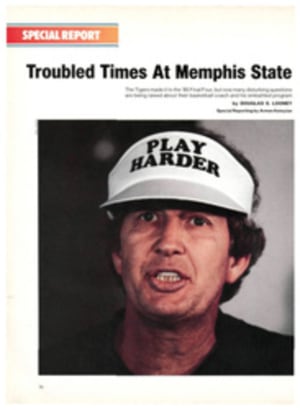
ZINA GARRISON HAS COME A LONG WAY TO RANK AMONG THE TOP 10 IN TENNIS
MacGregor Park in Houston's Third Ward has been the scene of riots, shootings, robberies and drug dealing. Nevertheless, from its tennis courts has come a player of shining talent, Zina Garrison. Indeed, as of June 3 she was ranked No. 7 in the world, after having been upset at the French Open.
Garrison brings impressive credentials to any event. She won the Wimbledon and U.S. Open Junior titles in 1981, turned pro in 1982 and has been in the Top 10 since 1983. In April of this year, she came from 3-0 down in the first set to beat Chris Evert Lloyd 6-4, 6-3 and win the WTA championships at Amelia Island, Fla. She had reached the finals by defeating Hana Mandlikova in straight sets.
Garrison is a womanchild in a very promising land. She earned $179,000 in prize money last year, but she drives a leased car because she can't decide whether to buy a Mercedes or a Corvette. Until recently, braces glittered on her teeth, yet her nails are polished and her fingers, neck and ears sparkle with jewelry. When asked if there is a special boyfriend in her life, she giggles before explaining that the boyfriend in Los Angeles would be mad if he found out about the one in Houston. A moment later, she is an adult speaking of her desire to adopt children someday.
"Sometimes I think people have trouble trying to figure me out," she says. "I don't talk that much, except to close friends. It's not that I'm shy, but I like to know someone really well before I confide in them." At 21, Garrison is still about the business of growing up.
As is her tennis game. "Her biggest weakness, and I think Zina knows this, is her serve," says Martina Navratilova. "But it's not any worse than Chris's and she got pretty far with a mediocre serve. Zina has all the shots, really. She has the legs and the brain. I don't see anything holding her back."
Except, perhaps, those great expectations. On her 5'4½", 128-pound frame, Garrison carries not only her own hopes and desires, but also those of her friends, family and race. She is the first black woman since Althea Gibson in 1957 to crack the Top 10, and the first black American since Arthur Ashe to make a consistent impact on the tennis circuit.
Garrison's father, U.L., died of a stroke when Zina was nine months old. Her older brother, Willie, a promising catcher drafted by the Milwaukee Braves organization in 1963, was hit in the eye by an errant ball thrown during practice and died, two years later, of a brain tumor attributed to that mishap. Although five other siblings remained, they were so much older (by at least 10 years) that Zina considered herself an only child. Then, in 1983, her mother, Mary, died of diabetic complications.
Feeling lost and alone, Garrison found support elsewhere. First, there were her sisters and brothers and their families. Then there were close family friends, like her "second parents," Lorenzo and Berdie Simmons, who would take her with them on crabbing expeditions to Galveston. Finally, there were the folks at MacGregor. In 1973, John Wilkerson was tennis pro there, and he began a free children's tennis program. Garrison was 10 at the time, a natural athlete who was already playing softball. She set her junior high school's record in the mile and won a number of dance contests. Her brother, Rodney, introduced her to Wilkerson and Wilkerson introduced her to tennis. Eventually, he became her coach and she the attentive pupil.
Perhaps too attentive. Garrison lost her first national tournament (the 12s Hard Courts in 1976) 6-0, 6-0 to the eventual champion, Carol Heynen. Two weeks later, Garrison again faced Heynen and, mindful of Wilkerson's instructions, drop-shotted her way to a 5-1 lead. Heynen caught on and started running to the net, and Garrison, still heeding Wilkerson's advice, lost the match. "My first question to her was, 'Why did you keep drop-shotting?' " Wilkerson recalls. "Zina said, 'That's what you told me to do.' " He notes with satisfaction, however, that Garrison never lost to Heynen again.
For Garrison, hard work off the court has led to improvement on it. By 1979 she was No. 1 in Texas' 16-and-under division, and over the next two years she accrued six sectional and six national titles in both singles and doubles.
Three months ago, she started working out at The Ladies Gym in Houston and, under the supervision of instructor Moses Vincent, has begun triceps exercises to strengthen her backhand, trunk curls to help her lower back, and short sprints and jumping jacks to improve her lateral motion on court. Her goal for this year is to break into the top three, and those who work closely with her say she'll make it—if not this year, then in the next two or three.
Recently, John Wilkerson sat shading his eyes beneath a hot Houston sun as he watched Navratilova roll over yet another human obstacle on the way to yet another tournament victory. "Did you ever notice that the more successful Martina is, the lighter her hair gets?" he asked.
Sandra Hughes, one of Wilkerson's pupils, nodded and said, "Now that you mention it, I think Zina's hair is turning blonde, too."
They laughed and resumed watching the match.
PHOTO
CHERYL A. TRAENDLY
Garrison rushed to prominence at Amelia Island.

